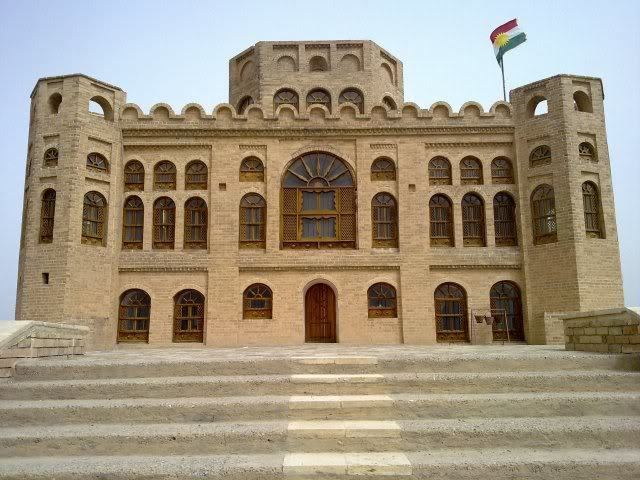Phone +964 750 165 0353 | ||
 | ||
Similar Fort Almnterp, Taqa Castle, Fort Jalan Bani Buhassan, Quriyat Castle, Alrmaila Fort | ||
Sherwana Castle, also known as Shirwanah Castle, is located in Kalar, Kurdistan, Iraq.
Contents
History
Built by Mohamed Pasha Jaff, Kurdish king named by the Ottomans Empire in the 1800s. After the Mamluk Vali of Baghdad, Suleiaman Pasha, dealt a crushing defeat to the Persian occupation of Abbas Mirza Qajar of Northern Mesopatamia, and put to flight the Babans in 1850, Mohamed Pasha Jaff along with the Jaff nomads were allowed to dwell in the Shahrizor unhurrassed by the Ottomans or Persians in any way. A golden age began for the Jaff as they became a major power in the region.
They're nomadic caravans were allowed pasture from Khanaqin and Qizil Rubat to Panjwin in the Shahrizor region of Kurdistan. In these regions Mohammed Pasha Jaff from his position of power began to crack down on all of his enemies from the Pro Baban Jaff under Aziz Beg Jaff, who was the son of Kai Khasrow Beg Jaff to the rival tribe of the Hemevand, who were anti Ottoman and Anti everything. He would erect a Fortress on the banks of the Shirwan river to guard against all of these foes in 1866.
This fortress is now known as the Shirwana fortress. In 1868, he would be appoined by the Mamluk Vali Suliaman Pasha of Baghdad. However Suliaman Pasha and Mohammed Pasha Jaff's power would begin to weaken during the Russo Ottoman war around 1878. The Jaff's rivals, Hamavands, would go to the Caucasus and fight under for the Russians against the Ottomans. The Russians would arm them and send them back to agitate the Shahrizor and create anarchy.
They in collaboration with the Aziz Beg Jaff faction would launch an attack against Mohamed Pasha Jaff, killing him in 1880. Osman Pasha Jaff's son, would be given the residence of the fortress, as his father concerned himself with the affairs of Gulanbar and Halabja, Mohammed Ali Beg Jaff. During World War I the Jaff and the Kurds would fall into obscurity as most of the war took place in the South between the Ottomans and British, fighting a back forth battle around Kut, which the Ottomans would deal the British their worst defeat during the war. The British would finally get the upper hand through other fronts, the Palestine front especially. The Ottomans would sign the Treaty of Mudros in 1917. The British would then occupy Mesopatamia, and the Ottoman Empire would cease to exist. During the British Occupation much of the Kurdish population would revolt under Sheikh Mustafa Barzani, whose power base was in Suliamania in 1918, 1922-1924, including segments of the Jaff tribe. The British would end up destroying many Palaces and Fortresses built by the Kurds. Sherwana Castle was the exception, since it had been built in such an obscure area.
The Castle would become insignificant as the Jaff leadership would eventually flee to Persia, and become close to the Pahlavis. In 1989 Saddam Hussein in a visit to the region to strengthen relations with Kurds would go on tour of much of the old structures of the region. He was much interested in making an Iraqi historiagraphy. The Castle of Sherwana would be one of the structures he visited. He would give it much publicity together with Jaff scholars. The Sherwana Castle would be declared as a historic site under Saddam Hussein. It would eventually be given a specific government agency to manage it. Today, it Houses the Museam of Kalar, which has many historic artifacts of the Jaff tribe.
Exterior
The Sherwana Castle sits on top of a mound two stories high, and has eight cases of nine steps each leading up to the entrance. The entrance is under a grand arched window with two narrow arched windows and two small arched windows on each side. On each side of these are three more narrow long arched windows and three small windows at the top. The back entrance is similar, with four narrow long windows on each side and four small windows at the top. Each of the four towers at the corners has three windows on all sides. The top one of these has no glass, to enable rifles to be placed on those positions. The roof of the castle has a building on top with four sides. There are six windows on each side and two windows on its corners, which protrude out in a hexagon shape. The roof of this building has a Persian appearance with wavy crenallations.
Interior
The inside has a monochromatic white appearance. The rooms are compartmentalized with many arches in which to put vases and tea sets. There are two stories with the second story containing lounge rooms by the grand windows above the entrances, which overlook all of Kalar. The top building contains mainly storage rooms.
